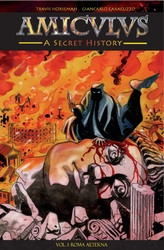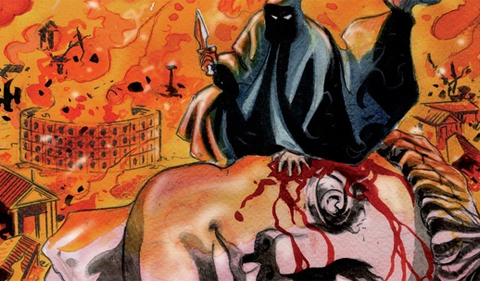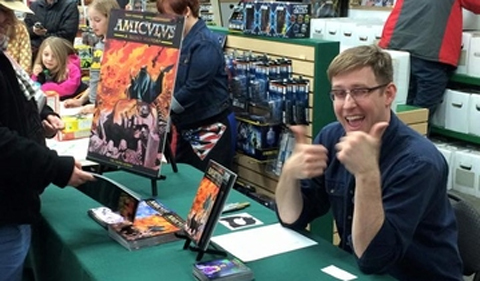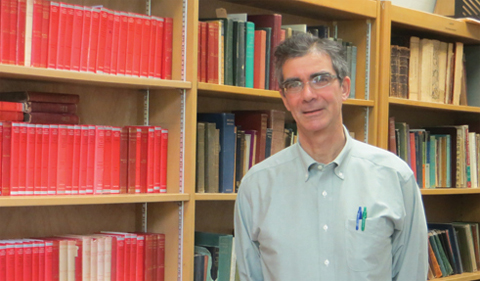By Lori Price
Amiculus: A Secret History is a new character’s view of the fall of Rome.
It all started out as a 10-page project in a scriptwriting class when Travis Horseman ’99 was an undergraduate student at Ohio University.
His major was Acting and Theater, but he also had a strong interest in the classics and classical languages. That kernel of a script has grown, and now Horseman has just unveiled it as the first book of his trilogy, Amiculus: A Secret History, which deals with ancient Rome.
Horseman will be in Athens, Ohio, on May 8-9, 2015, as a featured speaker at the Ratha Con 2015 comic book convention at the Athens Community Center.
The Influence of Classics and Greek
He recalls one influential class that had a significant impact on his burgeoning interest in the Classical world. The class on Roman slavery, taught by Dr. William Owens, Associate Professor and Chair of Classics & World Religions, an expert on ancient slavery and Roman society, provided Horseman with the creative writing tools to examine historical fiction. He became fascinated with the idea of telling fictional stories closely woven with threads of historical fact.
In addition to classes with Owens, Horseman was greatly influenced by his Greek language classes with Dr. Steve Hays, Associate Professor of Classics & World Religions.
“The study of Greek provided me with the mindset of that culture and gave me the language to express that mindset more accurately. My studies in the Classics & World Religions department gave me a richer sense of what I would be describing in my creative fiction,” he says.
Watch him introduce Amiculus on YouTube.
Horseman was able to do more than study Greek from his Ohio University classroom. During his last quarter, he was able combine an OHIO grant and private funding to enable him to participate in a language study abroad program in Greece. He had the opportunity to study the works of Homer and other ancient texts in the region in which they were originally written. While abroad, Travis had the opportunity to visit several sites in both Greece and Italy.
“Although I experienced modern culture, in that area the modern culture still has a strong element of the ancient one. My travels in the region brought a level of verisimilitude to my writing that I wouldn’t have had otherwise.”
Bringing the ‘Amiculus’ to Life
With such a strong classical influence and an academic grounding in the Greek and Latin languages, one might expect that Horseman’s book would be more formal in nature. However, it is not a traditional work of literature, it is a graphic novel.
“Comics are a rapidly growing industry, adding additional readers each year beyond the hard-core fans. Many of the new readers then become fans themselves. There are a huge variety of themes and stories represented,” Horseman explains.
 His story centers around Romulus, the 12-year-old boy who was the last emperor of Rome. Set in the year A.D. 538, it tells the story of the fall of Rome and examines how and why the Western Roman Empire fell. Horseman adds excitement and interest with hints of a shadowy, mysterious character who may have played a pivotal role in orchestrating this profound historical event.
His story centers around Romulus, the 12-year-old boy who was the last emperor of Rome. Set in the year A.D. 538, it tells the story of the fall of Rome and examines how and why the Western Roman Empire fell. Horseman adds excitement and interest with hints of a shadowy, mysterious character who may have played a pivotal role in orchestrating this profound historical event.
“My novel has had a very positive reception in the comic book community. People are drawn to interesting stories across all formats. The graphic novel fills the space between films and prose, however I think it is closer to the visual nature of film,” Horseman says. “It is not surprising to me that so many graphic novels have been adapted for film, since the graphic novel format is already in the form of a storyboard, like those used to create films.”
On the online professional network, LinkedIn, he met his illustrator, Giancarlo Caracuzzo, who is from Italy and who was able to help add to the authenticity of the visual scenes in the book. Caracuzzo’s daughter signed on as his colorist. Horseman was overjoyed to be able to find such talented people of a similar mindset to help bring his book to life.
He began his novel with a shorter length, preview comic that he paid for out of pocket. At that point, he took another action not common in the traditional publishing realm, he sought the necessary funding to produce his work through Kickstarter, an online based funding platform that provides financial backers the opportunity to partner with creative individuals in need of funding to produce specific projects.
Horseman’s first interaction with Kickstarter did not achieve the success he desired, so due to funding constraints he decided to publish his novel in three 60-page volumes rather than as one single work. He shared that he would ultimately like to combine the three volumes into one book once the initial funding and publishing efforts are complete. His Volume II Kickstarter campaign begins June 1.
He has been pleased with the comic book industry and has found it to be a very warm and welcoming place socially. Professionally, however, he explains that he has found it to be similar to the environment in other artistic communities he has experienced.
“There is a somewhat limited number of places that are open or ways to break into this industry as a professional,” he says. His advice to other writers who are interested in a profession in this industry comes directly from his own experience.
“Don’t spend too much time trying to make your work perfect. It will go through multiple drafts. I did probably 20 drafts of my story over a four-year period.” Horesman also encourages boldness.
‘Don’t Wait Until the Time Is Right’
“Don’t wait until the time is right. Don’t be afraid. This is a growing industry and there is an ever growing need for additional voices and new stories here.” He does, however, caution that it might be better not to try to introduce yet another super hero tale. He encourages people to bring their own stories, based on their own unique interests, and to create new and unique worlds for the readers, just as he has done.
Not only has Horseman encountered a high degree of acceptance within the graphic novel industry and the comic book genre, he also has become somewhat of an authority on the use of Kickstarter and how to integrate that program with a specific project. He will be participating in several comic book conventions throughout the Midwest in the coming months, where he will be presenting his book and also speaking about how to utilize Kickstarter to get projects funded.
When Horseman first started in his class at Ohio University with his script of a story about ancient Rome, he never dreamed that it would go this far or move in this particular direction. However he is ready and willing to take full advantage of all the opportunities that have come with this project. He is excited to share that which he has learned with others who are willing to venture to this new horizon of storytelling.





















Comments